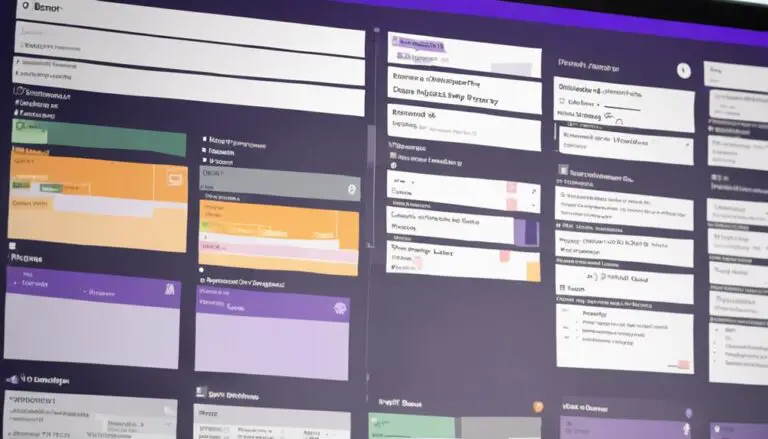You might think sprints and Kanban are like oil and water, but what if you could blend them seamlessly for optimal results?
By understanding how to adapt sprint methodologies within the Kanban framework, you can unlock a new level of efficiency and team collaboration.
The fusion of these two seemingly contrasting approaches holds the key to achieving a harmonious balance in your project management.
Explore the possibilities of enhancing your workflow through this innovative integration.
Key Takeaways
- Kanban sprints enhance workflow efficiency and goal achievement.
- Implement WIP limits to avoid bottlenecks and ensure steady progress.
- Collaborate effectively to manage work overflow and drive successful outcomes.
- Prioritize tasks, optimize workflow, and achieve project goals with Kanban sprints.
Benefits of Integrating Sprints in Kanban
Integrating sprints into your Kanban workflow brings several key advantages that enhance your team's productivity and effectiveness. Sprint goals set specific targets for your team to achieve within a defined time frame, fostering a sense of focus and urgency. By working within WIP limits on your Kanban boards during sprints, you ensure that tasks move smoothly across the workflow, avoiding bottlenecks and overburdening team members. Tracking velocity during sprints allows you to measure your team's performance accurately, providing insights into how efficiently work is being completed.
Moreover, the combination of sprints and Kanban enables continuous improvement. Through regular sprint retrospectives, your team can reflect on what went well and what could be enhanced, fostering a culture of learning and adaptation. This iterative process ensures that your team is constantly refining their practices, optimizing workflow efficiency, and delivering incremental value to stakeholders consistently. By leveraging the benefits of sprints within Kanban, you can achieve a balance between predictability and flexibility while driving continuous growth and improvement.
Effective Sprint Planning Techniques in Kanban
Let's talk about aligning sprint goals and mastering capacity planning techniques in Kanban.
By ensuring your sprint goals are in sync with your team's overall objectives, you can boost productivity and focus.
Implementing effective capacity planning techniques will help you allocate work efficiently, maintain a steady workflow, and deliver results consistently.
Sprint Goals Alignment
Aligning sprint goals with business priorities is crucial for ensuring effective sprint planning techniques in Kanban. In Kanban, Scrum Teams define sprint goals based on product backlog items they'd work on, aligning them with the Kanban Guide for Scrum. This alignment ensures that the team focuses on delivering maximum value to the business.
Especially when working on mature products, understanding the average velocity helps in setting achievable goals that align with what the business values most. By aligning sprint goals with business priorities, teams can optimize their efforts and deliver outcomes that truly matter, making sprint planning in Kanban a strategic and value-driven process.
Capacity Planning Techniques
Calculating team capacity in Kanban involves analyzing available resources and historical data to effectively plan sprints.
To enhance your capacity planning techniques, consider the following:
- Utilize Cumulative Flow Diagrams: Visualize work capacity and distribution over time to track progress effectively.
- Limit Work in Progress (WIP): Maintain a sustainable pace by setting WIP limits, enabling smoother workflow and better sprint planning.
- Leverage Lead Time and Cycle Time Metrics: Understand team performance through lead time (time to complete a task) and cycle time (time between tasks) metrics, aiding in improving capacity planning accuracy.
Managing Work Overflow in Kanban Sprints
When managing work overflow in Kanban Sprints, setting work capacity limits is crucial for maintaining control over the number of tasks being worked on simultaneously.
Prioritizing backlog items ensures that the most important tasks are addressed first, preventing bottlenecks and optimizing workflow efficiency.
Effective team collaboration is key in handling work overflow efficiently, enabling swift problem-solving and adaptability to changing priorities.
Work Capacity Limits
To effectively manage work overflow in Kanban sprints, setting work capacity limits through WIP constraints is crucial for enhancing team productivity and workflow stability. Here are three key points to consider:
- Efficient Task Completion: Limiting work in progress (WIP) allows teams to focus on completing tasks efficiently within Kanban sprints.
- Avoiding Overload: Setting WIP limits ensures that teams don't take on more tasks than they can handle at any given time, reducing work overflow.
- Enhanced Productivity: By controlling the number of tasks in progress, teams experience improved productivity, smoother task transitions, and overall enhanced performance in Kanban sprints.
Prioritizing Backlog Items
Start by prioritizing backlog items in Kanban sprints to effectively manage work overflow and ensure the most important tasks are addressed first. In Kanban, prioritizing backlog items based on value, urgency, and dependencies is crucial for maintaining an efficient workflow.
By understanding the priority of each task, teams can focus on what matters most, avoiding bottlenecks and ensuring a steady flow of work. Constant communication within the team is essential to adjust priorities as needed and keep the workflow on track.
Techniques like setting work in progress (WIP) limits and visualizing work progress aid in managing and prioritizing backlog items effectively. Prioritizing tasks in Kanban sprints empowers teams to work collaboratively towards achieving their goals efficiently.
Optimal Team Collaboration
To enhance your team's efficiency in Kanban sprints, managing work overflow through WIP limits on the Kanban board is crucial for optimal collaboration. Here are three key points to help you navigate work overflow and maximize team productivity:
- Preventing Task Overload: Setting WIP limits ensures that team members focus on a manageable number of tasks, avoiding overwhelm and promoting task completion.
- Real-time Visualization: By visualizing work progress on the Kanban board, team members can address bottlenecks promptly, leading to smoother task flow and improved collaboration.
- Enhanced Team Communication: Managing work overflow fosters better team communication, coordination, and productivity during Kanban Sprints, ultimately driving successful outcomes.
Improving Productivity Through Kanban Sprints
Enhancing team productivity through the integration of Kanban Sprints involves setting time-boxed iterations within the framework to focus on specific tasks or goals. By incorporating Sprints in Kanban, you can effectively manage work, prioritize tasks on the Kanban board, and deliver incremental value with each iteration. This approach not only enhances productivity but also ensures a continuous flow of work, breaking down complex projects into manageable chunks. With Kanban Sprints, you can improve task visibility, making it easier to track progress and identify potential bottlenecks.
Teams utilizing Kanban Sprints experience increased collaboration among team members, better task management, and faster feedback loops. This collaborative environment fosters a sense of belonging and shared responsibility, leading to more efficient outcomes. Additionally, implementing Sprints in Kanban allows you to adapt to changing priorities swiftly, maintain a steady workflow, and achieve iterative improvements. Overall, Kanban Sprints are a valuable tool for boosting productivity and achieving successful project outcomes.
Enhancing Workflow Efficiency With Kanban Sprints
With Kanban Sprints, teams can streamline workflow efficiency through continuous flow and iterative optimization within the framework. Here are three ways Kanban Sprints enhance workflow efficiency:
- Continuous Flow: Kanban Sprints enable a steady workflow by visualizing work progress and limiting work in progress. This continuous flow helps teams identify bottlenecks and keep work moving smoothly.
- Workflow Optimization: By using Kanban Sprints, teams can optimize task completion efficiency. Through setting time-bound goals and managing work in iterations, teams can enhance their overall workflow efficiency and productivity.
- Task Prioritization: Integrating Sprints in Kanban enhances task prioritization. Teams can focus on completing high-priority tasks first, leading to improved team collaboration and streamlined workflow efficiency.
Achieving Project Goals With Kanban Sprints
Achieve your project goals effectively by leveraging the power of Kanban sprints for iterative and incremental task completion within the framework. Kanban sprints provide a structured approach to meeting project objectives by focusing on flow efficiency and continuous improvement.
By breaking down tasks into manageable units and setting time limits for their completion, teams can make steady progress towards achieving project goals. Task prioritization becomes more streamlined as teams can visually track progress and adjust priorities as needed. This visual progress tracking not only helps in understanding the current status of tasks but also aids in making informed decisions for optimizing workflow efficiency.
With Kanban sprints, teams can manage work in progress effectively, ensuring a smooth and continuous workflow that leads to successful project outcomes. Embrace the collaborative nature of Kanban sprints to drive your team towards reaching and surpassing project goals.
Frequently Asked Questions
Can You Use Sprints in Kanban?
Yes, you can use sprints in Kanban by defining sprint duration, enhancing team collaboration, conducting daily stand-ups, prioritizing backlog grooming, focusing on continuous improvement, and holding sprint retrospectives for iterative development and workflow optimization. In Kanban, using sprints can help teams to create a more structured and focused workflow, allowing them to better manage their work and deliver value more consistently. By implementing a sprint execution strategy, teams can ensure that they are maximizing the benefits of sprints within the Kanban framework. This strategy may involve setting clear sprint goals, tracking progress regularly, and adapting the sprint plan as needed to address any unexpected challenges that arise. Ultimately, using sprints in Kanban can help teams to achieve greater efficiency and effectiveness in their work processes.
How Do I Manage Sprints in Kanban Board?
To manage sprints in a Kanban board effectively, start by sprint planning and task prioritization. Keep an eye on cycle time and work in progress. Facilitate continuous improvement through team collaboration. Stay agile and focused!
How Do I Convert My Kanban to Sprint?
To convert Kanban to Sprints, start with sprint planning for goal setting. Collaborate with the team on task prioritization. Engage in daily stand-ups for updates. Embrace timeboxing limits for focused work. Ensure continuous improvement for efficient workflows.
What Is the Sprint Goal in Kanban?
To maximize Sprint effectiveness in Kanban, focus on the Sprint goal as a beacon guiding your team's efforts. Embrace Kanban flexibility while enhancing workflow optimization, team collaboration, and continuous improvement. This approach boosts Sprint efficiency.
Conclusion
In conclusion, incorporating sprints into Kanban is like adding fuel to a well-oiled machine.
By utilizing flow-based sprint planning techniques, setting WIP limits, and tracking work item age, teams can enhance productivity, efficiency, and collaboration.
With the right tools and strategies in place, Kanban sprints can help you achieve your project goals with ease.
So, don't hesitate to implement this approach and watch your workflow soar like a bird in flight.





